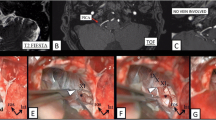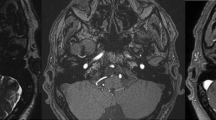Abstract.
Glossopharyngeal neuralgia is an uncommon craniofacial pain syndrome that is occasionally associated with cardiac syncope. However, we relate Chiari I syndrome as a cause of this clinical picture for the first time in the literature. The authors analyze the relevant literature and discuss the pathogenesis and treatment of associated syndromes. We describe the case of a 45-year-old female patient who presented with a 3-year history of left glossopharyngeal neuralgia with occasional dysphagia and episodes of syncope when eating or swallowing. The pain was not disseminated to the right side and was fairly well controlled by carbamazepine. The syncopal attacks had a duration of about 10 sec. Neurological examination elicited a faint dysphonia associated with paradoxical dysphagia. The cranial magnetic resonance imaging scan showed a bilateral herniation of the cerebellar tonsils through the foramen magnum, more evidently on the left side. The patient received a suboccipital craniectomy and resection of the posterior arch of C1. The dura mater was opened, and we found both tonsils displaced into the foramen magnum extending caudally toward the C1 level. Both tonsils were compressing the brainstem and especially the low cranial nerves bilaterally. The lower cranial nerves were compressed between the posterior inferior cerebellar artery (PICA) and the herniated cerebellar tonsil on both sides. Both PICAs were dissected by microsurgical technique and all the arachnoid adherences were cut. The left tonsil was resected by means of ultrasonic aspirator. Duraplasty was performed with the occipital pericranium. The paroxysmal pain attacks and the syncopal picture disappeared immediately after the operation. The patient was discharged on the 7th postoperative day. One year later, she was free of symptoms. This case provides clinical evidence of close connections between the glossopharyngeal and vagus nerves, which control visceral sensation; and compression of the IX and X nerves between the herniated tonsil and PICA or vertebral artery may cause an irritative sensory phenomenon, which is the origin of the algic sensation and the cardiac syncope by means of cross talk between the fibers of the same nerve.
Similar content being viewed by others
Author information
Authors and Affiliations
Additional information
Electronic Publication
Rights and permissions
About this article
Cite this article
Aguiar, P., Tella, O., Pereira, C. et al. Chiari type I presenting as left glossopharyngeal neuralgia with cardiac syncope. Neurosurg Rev 25, 99–102 (2002). https://doi.org/10.1007/s101430100178
Received:
Accepted:
Published:
Issue Date:
DOI: https://doi.org/10.1007/s101430100178




